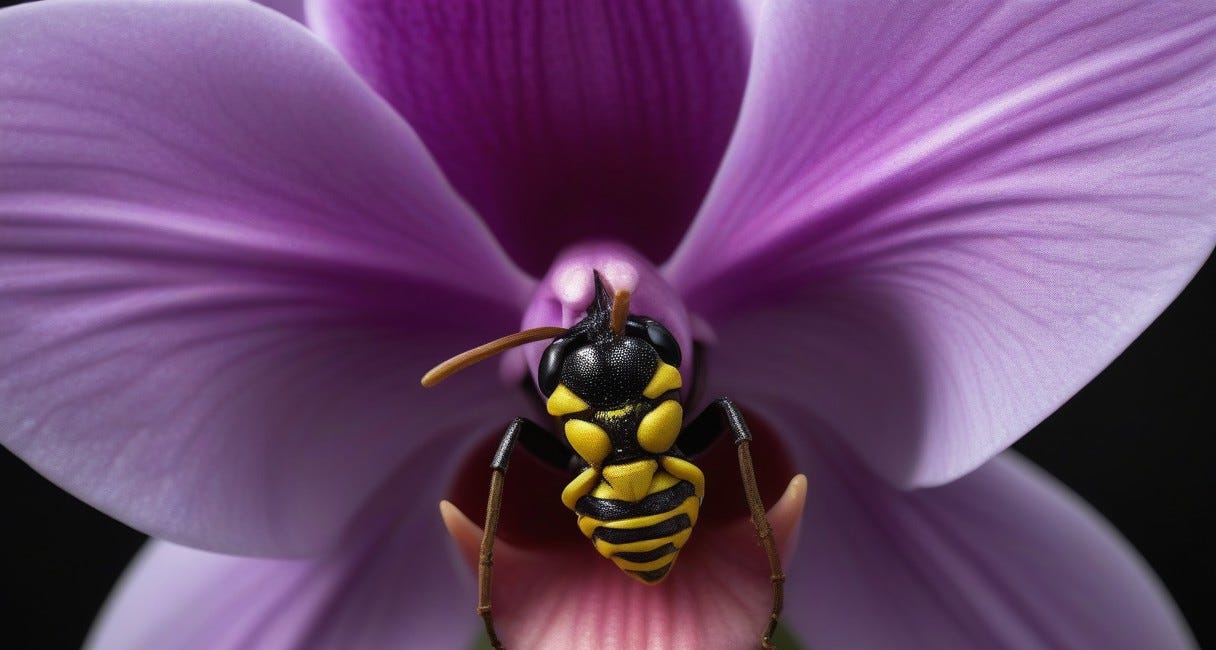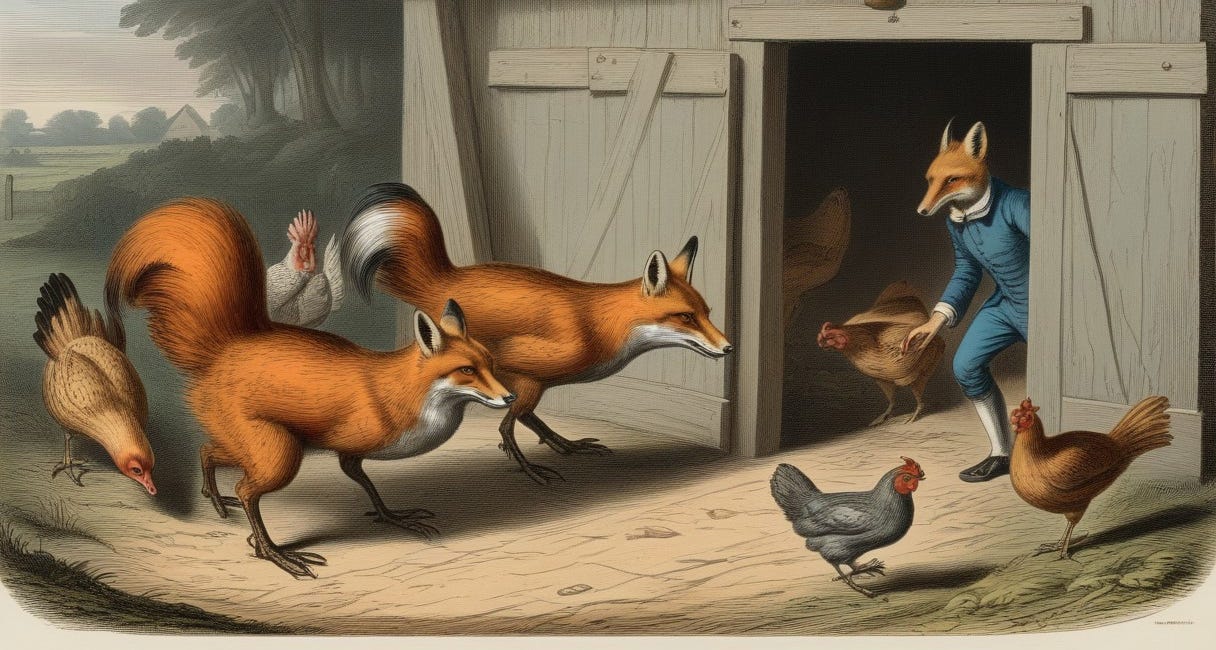mimesexuality 1: incipendum
a synthesis of a sexuality
incipendum
For years, I thought around the edges of this idea—fragments, patterns, contradictions that seemed meaningful but resisted coherence. Then, suddenly, the clarity arrived. The dots connected. What had felt like a hundred different questions collapsed into a single answer. Mimesexuality was not a cultural anomaly, not a new social construct, not a modern identity crisis—it was a natural phenomenon, an inevitable byproduct of sexual selection, an expected strategy in any species with imperfect recognition and high intra-male competition.
Defintion: Mimesexuality is a reproductive strategy in which a male mimics female appearance or behavior to bypass male-male competition and gain access to female social or sexual spaces. The mimesexual does not identify as female out of personal conviction, nor does he seek male partners like a gay man—his strategy is heterosexual, but indirect. By suppressing or altering the signals of maleness, he avoids aggression from dominant males, reduces female defenses, and positions himself within environments where other men are excluded. This is not a cultural phenomenon, not a modern identity crisis, but a recurring biological strategy observed across species, emerging wherever sex recognition is imperfect and competition is high. The mimesexual does not seduce as a man—he infiltrates as a mimic. His success depends on misrecognition, and his failure comes the moment he is seen for what he is.
Some will be annoyed because I have conjured up a new word—mimesexual. (As if naming something new is an act of aggression; as if the problem is not the phenomenon itself, but the refusal to describe it in familiar terms.) But the words we have—none of them are neutral. They are already loaded, already weighted down with cultural baggage, with ideological entanglements, with narratives that obscure more than they reveal. To use them would be to drag this conversation into the swamp of existing arguments, into the endless, useless nature-versus-nurture debates, into frameworks that fail because they were never built to explain anything biologically.
This essay will annoy. Some will say I am too harsh, that I do not show enough deference to mimesexuals and their experience, self-definition. Others will say I am too accepting, that I dignify mimicry by calling it natural instead of denouncing it as deviance. But biology does not require deference, nor does it take sides. It simply describes what is. Mimesexuality is not a choice, not an ideology, not a moral failing. It is a recurring pattern, a structure that appears whenever the conditions allow.
Many will annoyed by this essay because it seems treats men as predators and women as prey in reproductive strategies. (A framing that offends modern sensibilities; an idea that feels outdated, crude, unfair.) But this is not a moral claim—it is an observation of evolutionary asymmetry, a reflection of the unavoidable mechanics of sexual selection. Males, in every species with internal fertilization, compete for dominance in social hierarchies because their reproductive success is determined by access. Women, in contrast, compete for resources, security, and stability because their reproductive success is determined by survival. (Here, Bateman’s principle—the sex that invests more in reproduction becomes the limiting factor; the sex that invests less must compete for access.) This asymmetry is not cultural, not optional, not erasable. It is the structure that evolves, again and again, because it is the only one that becomes stable. (Men fight for mates; women fight for the conditions in which their offspring can survive. The mimesexual does not rewrite this system—he exploits its weakest point.)
So I start with fresh language. Mimesexual—mimesis (imitation, mimicry) fused with sexual (of or relating to reproductive behavior). Not a value judgment, not a diagnosis—a description of what is happening, framed as plainly as possible. These are not unfamiliar words, only an unfamiliar fusion. (Mimicry, already in use in evolutionary biology, in natural history, in ethology. Sexuality, already the term for reproductive strategies, for attraction, for selection. The two placed together, at last, in the way they have always belonged.) This is not an invention, only a clarification. And if a single word makes the argument clearer—if it allows us to see what we have been talking around for so long—then it is the right word.
The failure of prior explanations was their refusal to apply the same biological lens to humans that we apply to every other species. Instead of seeing mimicry for what it was—an opportunistic reproductive strategy, a natural loophole in sex recognition—people framed it as a sociological puzzle, a debate over nurture, identity, and constructed roles. But nature is not that complicated. What is true for cuttlefish and side-blotched lizards is also true for us. Once we see it, we cannot unsee it. And once we understand it, we can stop being confused.
I write about men mimicking women because this is the dominant pattern when mimicry is used as a reproductive strategy. The advantages are clear—access without competition, reduced male aggression, a loophole in the rigid structure of sexual selection. But mimicry moves in both directions. Women mimicking men, following the same evolutionary logic, do not seek access but control. Control over their own reproduction. Control over their survival. (Here, Darwin—selection is not only about who is chosen, but who avoids being chosen.) The female mimic does not imitate to deceive for entry, but to prevent pursuit, to regulate exposure, to shape the terms of her own vulnerability.
The mimesexual infiltrates, but the female mimic disappears. She minimizes risk, evades predation, alters perception in ways that reduce the pressures of male competition—not by passing into the category of women, but by stepping out of the category of the desirable. (A misdirection; a disguise; a refusal.) Mimicry is never neutral—it always serves a strategy. The difference is whether the strategy is to claim access or to deny it, to increase reproductive opportunity or to limit it, to gain control by moving closer or by stepping away. Either way, the principle remains the same: the body is read imperfectly, and where reading fails, mimicry thrives.
In the spotted hyena (Crocuta crocuta), it is the female who mimics the male—not to infiltrate, but to dominate. She is larger, stronger, more aggressive, her body flooded with testosterone, her clitoris elongated into a pseudo-penis that signals dominance over males and solidifies her position at the top of the pack. Here, mimicry is not deception for access—it is power. (Hierarchies shift when recognition falters; if the body codes as male, the body is treated as such.) By adopting the signals of maleness, the female hyena controls reproduction, regulates aggression, and ensures that dominance remains in female hands. (The inverse of the mimesexual—not passing downward into protection, but upward into authority. A mimicry that does not evade conflict, but intensifies it.)
rejecting gender
I reject the word gender in the domain of biology (in the domain of sociobiology; in the domain of anything that deals with evolutionary mechanics, sexual selection, or natural history). Gender is linguistic. A grammatical category (masculine; feminine; neuter—like French nouns, like Latin declensions, like the arbitrary way a ship is “she” but a rock is “it”). No animal has gender. They have sex. (A peacock does not identify as flamboyant; he is merely adorned. A female anglerfish does not recognize her male as subordinate; she simply absorbs him—literally, into her bloodstream.) Sex is biological, determined, selective. Gender is language, mutable, cultural. To impose one onto the other (to treat a cuttlefish’s deception as a role, to frame a lizard’s mimicry as expression) is not just misleading—it’s category error. Like asking whether a praying mantis identifies as a widow before she eats her mate.
I have, out of scholarly charity, helpfully clarified in my paraphrasing of Judith Butler where she—no doubt carelessly, distracted by the whirl of performatives—conflated grammar and behavior. (A common oversight; after all, who hasn’t mistaken a verb tense for a social cue?) To ensure that gender—linguistic, declensional, safely tethered to nouns—does not get mistaken for sex, which remains, inconveniently, a biological fact. I’m certain someone of Butler’s caliber—versed, no doubt, in both French critical theory and first-year Latin—simply overlooked the distinction. Easy to do, when one’s métier is blurring categories rather than defining them. Consider it a footnote she forgot to write—I’ve written it for her.
Which is why you will not see the word in these essays—nor its derivatives, nor the frameworks that depend on it. Unless I made a terrible, terrible mistake, or I simply must (in the terra dubia chapter). The topic is sex. Selection. Biology. Organisms competing, deceiving, adapting. Grammar has no place in biological imperatives.
You’ll notice, too, that I reject the term queer throughout (a word once sharp, pointed, defiant—now bloated, porous, meaning everything and nothing; a linguistic junk drawer where categories are tossed, scrambled, dissolved). I have no use for it. (Not because I object to difference—difference is the rule in biology, not the exception—but because I object to imprecision.) Queer smears together what should remain distinct—sex, desire, strategy, identity—flattening the map, erasing boundaries, substituting ambiguity for clarity. (It is not rebellious; it is lazy.) Biology is not queer. Behavior is not queer. Sex is not queer. The word functions now as a smokescreen—a soft blur where sharp lines once stood. I prefer the sharp lines.
It’s telling how the sprawling acronym—LGBTQ+—when pared down, resolves itself not into infinite fluidity, but back to biological constants: Lesbian and Gay, Bisexual and Straight. The physical parameters of actual sex. Strip away the rhetorical excess—the Q’s, the pluses, the ever-multiplying identities—and what remains are categories grounded in the unchanging facts of bodies: male, female, the directions of sex between them. Lesbian and Gay, rooted in same-sex sex, attraction, and love. Bisexual and Straight, variations within heterosexual potential. All tethered to the reality of sexed bodies, all still orbiting the binary duet of reproduction.
I focus on heterosexuality itself—because you cannot understand mimicry, or mimesexuality, without first acknowledging the reproductive framework it exploits. The mimic does not exist outside of heterosexuality; he is a subset within it. And so, despite the expanding acronym, the language always contracts back—to sex, to the material reality of male and female, to Lesbian, Gay, Bisexual, Straight. The physical, immutable parameters. Everything else dissolves.
to audiences
These essays are written for several audiences at once. For those concerned—rightly—about the erosion of women’s spaces, about the quiet dismantling of female autonomy, often in the name of inclusion (a word that stretches, thins, dissolves boundaries until they vanish entirely). For those curious about human biology, who recognize patterns in nature and wonder why human behavior is so often treated as exempt (as if we, uniquely, float above reproductive strategy, selection pressure, deception). For readers schooled in the writings of Baudrillard, Barthes, Butler (oh my)—the theorists who taught us to read signs, masks, performances—only here turned slightly askew, their tools inverted, the same mechanics now applied not to liberate identity, but to reveal mimicry beneath it. And finally, for those, like me, troubled by what is done to vulnerable people—young people, lesbian and gay people, women—under the auspices of progress, when what is happening is something older, rawer, something with teeth: the mutilation of autonomy disguised as affirmation. Each audience will find something here—a lens, a warning, a pattern they recognize (whether they like it or not).
At the foundation of these essays (beneath the natural history, beneath the social observations, beneath the mimics and their strategies) lie several essential, unglamorous, factual assumptions I take my audience to share—the mechanics no one can rewrite, no matter how florid the cultural gloss. Humans reproduce sexually (solo performances—parthenogenesis, mitosis—not on the program). Two sexes, a duet—male and female, sperm and egg, each incomplete without the other. The genetic script: a vigintritet, 22 pairs and one rogue set of sex chromosomes, recombined, shuffled like a deck in every generation. (We are all improvisations on a fixed scale—Bach’s fugue meets evolutionary jazz.)
Each chromosome itself—a quartet of base units (A, T, C, G), simple, blunt, unadorned. No poetry in the letters, only in the arrangement. And this—this is the architecture we inherit. The raw material. The script. No amount of linguistic acrobatics, no clever post-structural pirouette, no semantic stretching, alters the fact that our entire species is orchestrated by this mechanism: duet sex, quartet bases, vigintritet chromosomes. We remix, yes. We vary, yes. But the form does not change. The structure persists. The rules predate the words we use to describe them.
And embedded in these chromosomes—not as metaphor, but as material—is the physical reality of all sexual strategies. The ontogenesis of mimesexuality, as surely as of heterosexuality, homosexuality, aggression, submission. Each behavior, each inclination, each strategy—a trace written in the 23. I am a firm believer (dogmatic, unapologetic) that mimesexuality is no cultural anomaly, no sociological quirk. It is an evolutionary fact, as natural as courtship, as territoriality, as the sex binary itself. Encoded in the genome, shaped by selection pressures, expressed across species. The mimic operates within these chromosomes—not despite them, but because of them. The structure was here long before anyone tried to give it another name.
There is also a particular audience I hope finds its way here—the psychiatrists, the psychologists, the social workers, the counselors—the workers of the mind, the ones tasked with care, but who instead stood by, nodding, as women’s spaces dissolved, as gays and lesbians were redefined, as children were ushered toward irreversible decisions. This is for them.
It begins, as it always seems to, with the psychiatrists. R.D. Laing, once Tavistock’s own, who treated delusion not as rupture but misunderstood narrative—something to be affirmed, indulged, never corrected. And then—John Money, whose theories were not born in Tavistock but whose ideas metastasized there. Tavistock became the institution where the mind’s distortions were not treated but enacted, where affirmation replaced inquiry, where mimicry became clinical gospel, handed down as if truth.
And it did not stop with words. It advanced. Doubt converted into dogma, and dogma sharpened into scalpels. Bodies—healthy, intact—were cut open, organs removed, hormones suppressed, fertility discarded, all in service of the mimic’s script. Tavistock—a clinic in name, but something colder, more ritualistic in practice—a medieval theater where delusion was not treated but carved, sutured, bled into the flesh.
to form
These essays take the form (or at least the gesture) of an outline—a skeleton, unfinished, deliberately high-density, elliptical. Think of them less as completed argument, more as scaffolding (the frame upon which whole books could be hung). A few paragraphs here on teenage angst over puberty—leveraging bodily confusion, turning transient discomfort into permanent identity—well, that’s a book. (A book with footnotes trailing back to Rousseau, to Freud, to Tumblr.) The difference between how boys and girls metabolize that discomfort (one externalized, one internalized)—that’s another book (or dissertation, or polemic; depends on the reader).
The ability of women, historically, biologically, to confuse men—to short-circuit male dominance, to weaponize ambiguity, to seize self-determination in the face of brute force (call it feminine mimesis, call it strategic opacity)—a book. Or two. (I concern myself here only with male mimicry—the other inversion, the other edge of the strategy, a mirror held at a slant.)
The underlying mechanisms—genetic, biochemical, neurological—that allow mimicry to persist, to be selected for, to ride invisibly through generations—books again. (E.O. Wilson must have had an inkling. Darwin, squinting at finches and barnacles, too.) The search for the substrate, the physical correlates—the genes that fine-tune recognition, the subtle conservations and mutations. Apotemnophilia. Autotopagnosia. Alexithymia. The body’s quiet betrayals. (Look here, not at sex-changes—impossible; dead-end—but at the conserved cognitive blind spots.) There’s research to be done, PhDs to be minted.
Lesbians and gays—conceptually adjacent, factually distinct (they map differently onto competition, onto mimicry, onto survival). Game theory (Nash knew something; the payoff matrix has more than two players here). The dizzy, baroque hierarchy of sexual delusion—I count seven levels, each one requiring its own taxonomy (each one, frankly, deserving its own chapter, or book, or index card left on a café table).
Another time. What’s here is only a fragment. Enough to see the shape. Enough to know there is much more.













The Sneaky Fucker Strategy literally on steroids? It makes so much sense to me, especially the control part that I’ve noticed with my daughter and her trans-identifying friends all seeking to escape the bounds of womanhood but not because they want to be treated as men.
The affirmative model is a problem. You nailed it - affirmation should be replaced with inquiry.
When someone needs help, the helping professions need to INQUIRE as to what is going on.